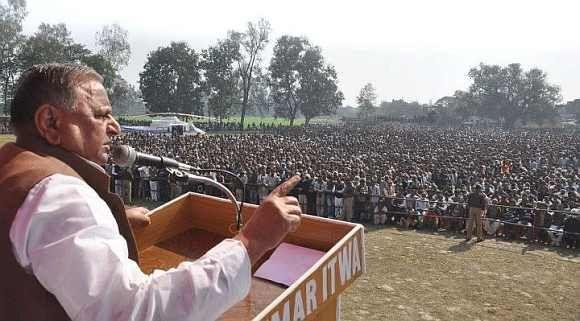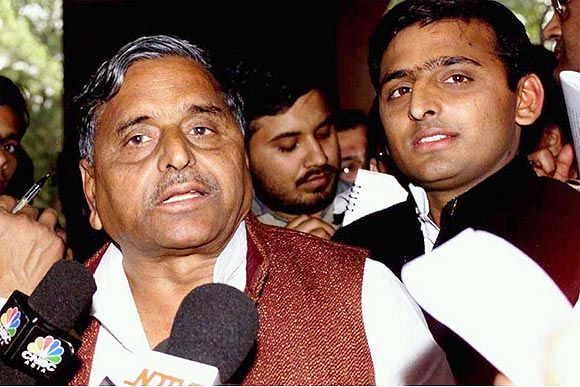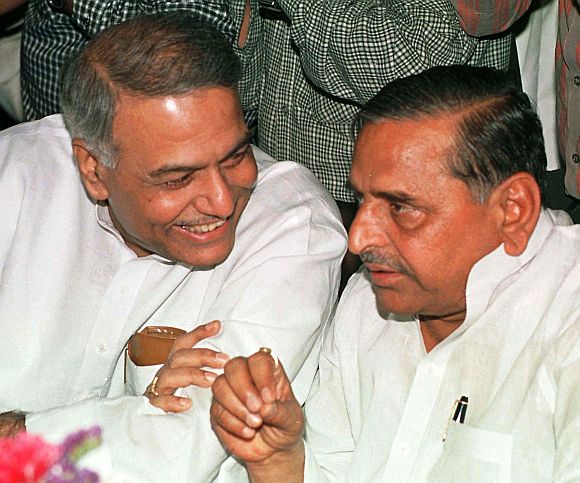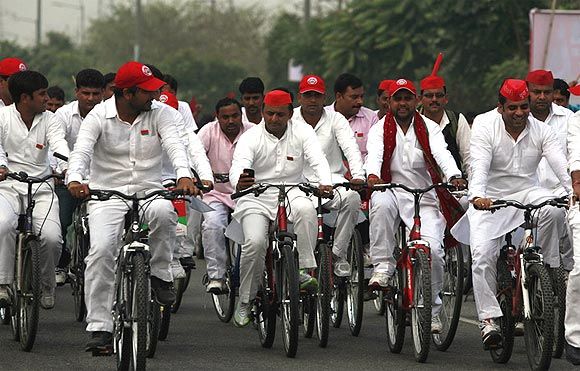 | « Back to article | Print this article |
'I'm not dead': The story of Mulayam's sweet revenge
It was sweet revenge for Mulayam Singh Yadav on Tuesday five years after Mayawati famously said "why kill a dead man" after the Samajwadi supremo was ousted by her in a crushing defeat.
The deadpan "dead-man" comment--"Marey hue ko kya marna (why kill a dead man)?"-- will perhaps return to haunt the Bahujan Samaj Party supremo after the Samajwadi rode to victory on the accomplished wrestler's influence at grassroots and his charismatic son Akhilesh writing the script for the party's effervescent victory in the country's most populous state.
Mayawati was asked then whether any FIRs will be filed against Mulayam.
Please click NEXT to read further...
Click here for more Realtime News on UP polls!
Yadav Jr took charge of SP to wrest UP back from his father's b te noire
As long as the party has existed, it has been Mulayam Singh Yadav's SP and that changed with the UP elections, when Yadav Jr took charge of the party's effort to wrest the state back from his father's bete noire.
The 39-year-old engineer-turned politician, who attempted a successful image makeover for the SP, is the man of the moment but chooses to underplay his role.
"The entire party worked hard and won," he says, thanking the people for "believing in the SP...people across caste and community voted for the SP," he said.
The party has for long had a lawless image, attacked as a "party of goons" by opponents and Akhilesh set about attempting to change that.
He insisted on hand-picking candidates unmindful of whose feet he stepped on, famously keeping the likes of DP Yadav away. Through his campaign he talked law and order as his party's foremost agenda.
After being down and out in last assembly elections, 72-year-old Mulayam known for his organising abilities and capability of mobilising cadre has turned the tables on in the current polls by gaining majority in the state, second after Mayawati, in the last 22 years.
He is tipped to become the chief minister for the fourth time.
'Dhartiputra' has seen his share of ups and downs
Popularly known as 'Dhartiputra' and called as 'Netaji' by his partymen, Mulayam has come a long way in UP politics.
Born in a farmer's family on November 22, 1939 in a non-descript town of Sefai in Etawah district, Mulayam got inspiration from Dr Ram Manohar Lohia at a tender age.
The SP supremo graduated from KK College in 1962 and later started his career as a teacher.
For the first time, Mulayam entered the UP state assembly as the Samajwadi Socialist Party candidate in 1967 and since then has never looked back.
Young Mulayam, who was jailed during emergency along with a large number of stalwarts of the non-Congress political parties, became a minister of state in Janta Party government led by Ram Naresh Yadav in 1977.
In 1980, he became the state president of Lok Dal and two years later he was elected as the Leader of Opposition in the state assembly.
In 1989, he became chief minister of UP for the first time when Congress was ousted on Bofors issue paving the way for the Janata Dal government.
When V P Singh government collapsed at the Centre in 1990 in the wake of Ram Temple movement, Janata Dal in UP also faced a vertical division, but Mulayam government survived with the support of Congress and lasted till June 1991.
In 1991, Mulayam government failed to make a return as BJP riding high on Ram wave formed its majority government under Kalyan Singh.
Post-Babri mosque demolition, Mulayam launched his own party Samajwadi Party with the help of his long standing colleagues Janeshwar Mishra, Mohd Azam Khan and Beni Prasad Verma and contested the 1993 polls in alliance with present day arch rival BSP and became the CM for the second time heading the SP-BSP alliance with the support of Congress and JD.
The SP-BSP government, however, collapsed in 1995 with BSP snapping ties and Mayawati becoming the CM for the first time with the support of BJP and other political parties.
In 1996, Mulayam, however, made a foray in the national politics and went on to become the defence minister in H D Deve Gowda-led United Front government.
With BJP and BSP forming the government in UP in 1997, which lasted for six months, and later BJP-led alliance continuing further, SP emerged as the single largest party in Vidhan Sabha elections of 2002 with 143 seats, but failed to form the government.
In 2002, BJP and BSP allied again and formed the government under Mayawati, which lasted for one and a half-years and the next year Mulayam became the CM for the third time.
This happened when BSP-BJP alliance failed to work for the second time in 2003.
In the third innings as CM, Mulayam continued till 2007 when his government was ousted from power on law and order front and alleged corruption charges and scams and BSP rising to power with absolute majority with 206 seats in a House of 403.
Akhilesh has been high on visibility
For Akhilesh, electioneering meant leading youth of the party on a bicycle, his party's political symbol, on the dust-tracks of UP.
He said he had faith in the party's gritty electoral fight to remove the BSP from power; personally that translated into a 10,000-km yatra, 800 rallies in UP over the last six months and a systematic attempt at an image makeover for his Samajwadi Party, all which have paid off.
Akhilesh has been high on visibility in these elections. The red Gandhi cap, white kurta pyjama and black sleeveless jacket have been ubiquitous as Akhilesh dashed to every corner of the state.
He cut his teeth in politics early. He schooled at the Sainik School in Dhaulpur, Rajasthan, and then acquired a degree in civil environment engineering from the Mysore University.
Akhilesh finished a masters in environmental engineering from the University of Sydney, Australia, in 1998 and was contemplating taking up water pollution projects when his father drafted him into politics.
He was 27 when he entered the Lok Sabha first, winning from Kannauj in 2000, when his father vacated the seat having won two -- Mainpuri and Kannauj. He has been the Kannauj MP since.



